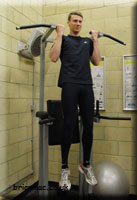

Flexed Arm-Hang Test
Testing and measurement are the means of collecting information upon which subsequent performance evaluations and decisions are made. In the analysis, we need to consider the factors influencing the results.
Objective
This test aims to monitor the muscular endurance of the athlete's elbow flexors and shoulder extensors.
Required Resources
To conduct this test, you will require:
- A bar above head height.
- A stopwatch.
- An assistant.
How to conduct the test
This test requires the athlete to perform and hold a chin-up position, using a bar above head height, for as long as possible.
|
 |
Assessment
The following normative data is available for this test:
|
Table adapted from Davis et al. (2000) [3]
Analysis
Analysis of the test result is done by comparing it with the athlete's previous results for this test. It is expected that, with appropriate training between each test, the analysis would indicate an improvement in the athlete's strength endurance (Cotten 1990)[1]
Target Group
This test is suitable for active athletes but not for individuals where the test would be contraindicated.
Reliability
Test reliability refers to how a test is consistent and stable in measuring what it is intended to measure. Reliability will depend upon how strictly the test is conducted and the individual's level of motivation to perform the test.
Validity
Test validity refers to the degree to which the test measures what it claims to measure and the extent to which inferences, conclusions, and decisions based on test scores are appropriate and meaningful. This test provides a means to monitor the effect of training on the athlete's physical development (Pate 1993)[2]
Advantages
- Minimal equipment is required.
- Simple to set up and conduct.
Disadvantages
- Assistant is required to administer the test.
References
- COTTEN, D.J. (1990) An analysis of the NCYFS II Modified Pull-up Test. Res Q Exerc Sport, 61 (3), p. 272-4.
- PATE, R.R. et al. (1993) Validity of field tests of upper body muscular strength. Res Q Exerc Sport, 64 (1), p. 17-24.
- DAVIS, B. et al. (2000) Physical Education and the Study of Sport. UK: London, Harcourt Publishers Ltd. p. 124 Table 4.4
Page Reference
If you quote information from this page in your work, then the reference for this page is:
- MACKENZIE, B. (2005) Flexed Arm-Hang Test [WWW] Available from: https://www.brianmac.co.uk/armtest.htm [Accessed